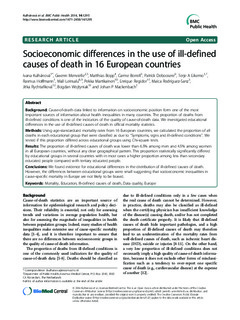Socioeconomic differences in the use of ill-defined causes of death in 16 European countries
Kulhanova, Ivana; Menvielle, G; Bopp, M; Borrell, C; Deboosere, P; Eikemo, Terje Andreas; Hoffmann, Rasmus; Leinsalu, M; Martikainen, P; Regidor, E; Rodriguez-Sanz, M; Rychtarikova, Jitka; Wojtyniak, Bogdan; Mackenbach, Johan P.
Journal article, Peer reviewed
Permanent lenke
http://hdl.handle.net/11250/429174Utgivelsesdato
2014Metadata
Vis full innførselSamlinger
Sammendrag
Background: Cause-of-death data linked to information on socioeconomic position form one of the most
important sources of information about health inequalities in many countries. The proportion of deaths from
ill-defined conditions is one of the indicators of the quality of cause-of-death data. We investigated educational
differences in the use of ill-defined causes of death in official mortality statistics.
Methods: Using age-standardized mortality rates from 16 European countries, we calculated the proportion of all
deaths in each educational group that were classified as due to “Symptoms, signs and ill-defined conditions”. We
tested if this proportion differed across educational groups using Chi-square tests.
Results: The proportion of ill-defined causes of death was lower than 6.5% among men and 4.5% among women
in all European countries, without any clear geographical pattern. This proportion statistically significantly differed
by educational groups in several countries with in most cases a higher proportion among less than secondary
educated people compared with tertiary educated people.
Conclusions: We found evidence for educational differences in the distribution of ill-defined causes of death.
However, the differences between educational groups were small suggesting that socioeconomic inequalities in
cause-specific mortality in Europe are not likely to be biased.
